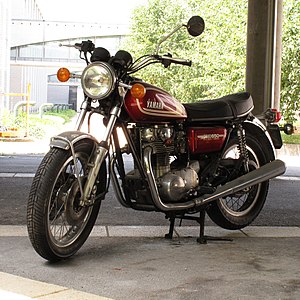 Yamaha XS650 | |
| Manufacturer | Yamaha Motor Company |
|---|---|
| Also called | XS-1, XS-2, TX 650 |
| Parent company | Yamaha Corporation |
| Production | 1969 (1970 model)–1985 1970–1983 (U.S)[1] |
| Successor | Yamaha XSR700 |
| Class | Standard |
| Engine | 654 cc (39.9 cu in), 4-stroke, parallel twin, air-cooled, SOHC, 2 valves per cylinder |
| Bore / stroke | 75 mm × 74 mm (3.0 in × 2.9 in) |
| Compression ratio | 8.4:1 |
| Top speed | 169 km/h (105 mph)[1] |
| Power | 40 kW (53 bhp) @ 7000 rpm (claimed)[1] |
| Ignition type | Contact point-pre 1980 TCI-post 1980 |
| Transmission | 5-Speed, manual |
| Frame type | tubular steel |
| Suspension | Front: telescopic Rear: swinging fork |
| Brakes | Front: Single disc (earlier models); twin disc (later models) Rear: drum |
| Tires | Front: 3.50 × 19 inch Rear 4.00 × 18 inch |
| Weight | 185 kg (408 lb)[1] (dry) 194 kg (428 lb)[1] (wet) |
| Fuel capacity | 3 US gal (11 L; 2 imp gal) or 4 US gal (15 L; 3 imp gal) |
The Yamaha XS650 is a mid-size[2] motorcycle that was made by the Yamaha Motor Company. The standard model was introduced in October 1969, and produced until 1979. The "Special" cruiser model was introduced in 1978 and produced until 1985. The XS650 began with the 1955 Hosk SOHC 500 twin. After about 10 years of producing 500 twin, Hosk engineers designed a 650 cc twin. Later Showa Corporation acquired the Hosk company, and in 1960 Yamaha acquired Showa, with Hosk's early design of 650 cc twin. [3]
When the Yamaha XS 650 was launched in October 1969 it had one of the most advanced reciprocating engines in its class of large parallel twin motorcycles. The engine and gearbox are unit construction with the crankcase split horizontally for ease of assembly, whereas almost all contemporaries in its class in 1969 are either unit construction with a vertically split crankcase or pre-unit construction with separate engine and gearbox. The XS650's engine was used in AMA Professional Dirt Track Racing by national champion Kenny Roberts. In 1969 only the Laverda 750S, and the Honda CB350, also launched that year, matched the XS 650's modernity of unit construction and SOHC valve operation.
- ^ a b c d e Anderson, Ric. "Yamaha XS650". Motorcycle Classics. Retrieved April 6, 2018.
- ^ Note: the XS650 is "mid-size" only by modern standards; when it was introduced in 1970 few bikes were larger than 750cc.
- ^ "Yamaha XS 650". Classic Japanese Bikes. Archived from the original on 2012-03-12. Retrieved 2012-04-16.